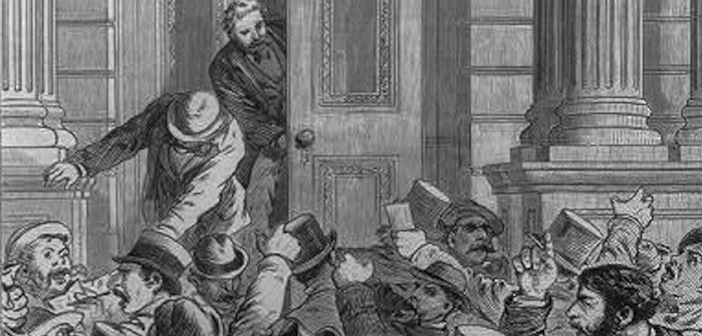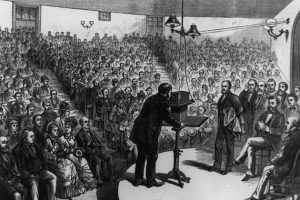Many Americans remember the Great Depression that left our country in financial ruin during the 1930’s.1 However, many of them are oblivious to the depression that was brought on by the Panic of 1873. Even fewer people are aware of the fact that the Panic of 1873 was dubbed the Great Depression until subsequent years when that title was won over by the decade encompassing the 1930’s.2 The 1930’s Great Depression, as we know it today, was brought on by a crash in the stock market (and various other factors, but mainly the events leading up to Black Tuesday, October 29, 1929).3 The Panic of 1873 had various causes that historians still debate for being the most responsible for the economic slump.

Unlike the Great Depression, the Panic of 1873 was brought on by high risk investments into the railroad building business. The demise of Jay Cooke & Company, the leading investor at the time, started a domino effect that was felt not only in the United States but also in Britain (triggering a severe two-decade long slump).4 The firm led financial efforts during the Civil War, and as a result of that, it became an agent for the federal government. Its promise was to build the second transcontinental railroad. By September 18, 1873, Cooke’s investment firm had declared bankruptcy.
The railroad building business was very risky; investors were essentially pouring their money into building industrial tracks leading to nowhere in hopes that the location would become prime locations for commerce. The leading firm, Jay Cooke & Company, decided to fold; a significant number of companies followed, approximately eighty-nine out of the existing three hundred sixty-four railroad companies.5 The majority of these companies declared bankruptcy within the first two years after Jay Cooke & Company declared bankruptcy, meaning that after having invested most of their monies into the railroad building business, most of those companies would rather take the loss than further invest any more money.6 This in turn caused more problems for the average citizen, because of the economic slump that would ensue.

Because industrialization was so vital for the early development of the United States, it is of no surprise that the railroad business was affected the most by that industrialization. The nation’s development was heavily rooted in the industrious railroad market of the time. Strikes, wage cuts, poor working conditions, less hours, and discrimination plagued the few in the working force. Panic had set in. Men were no longer able to provide for their families as they once did because of the decrease in pay and hours.7 This set up a perfect recipe for employers to take advantage; now they could demand more work for less pay because the unemployment rate was so high (peaking at 14%), so anybody looking for a job would have to take what they could.8 This employment competition led to poorer working conditions and even more discrimination, because any working class citizen would do whatever it took to survive during this time period.

The Panic of 1873 had some disastrous consequences. Aside from the corrupt politics of the time (for example, the Grant Administration Scandals), and the economic tatters the country was left in, the country’s values began to disintegrate as well. One of the most commonly known events, the Haymarket Affair, left seven people dead by a dynamite bomb during a labor demonstration, and many others were severely wounded.9 It seemed like the country would never recover; troops were deployed to various demonstrations as “peace keepers,” but only more violence would ensue. In order for change to occur, new methods would have to be implemented.
The Panic of 1873 never really ended; various factors ultimately led to an upward trend in the economy, and in turn, the growth of the nation again. Investors began to be more cautious with their monies, the government took responsibility for the corruption, and ultimately the country’s morale began to boost. This upward trend led the nation out of its first great depression.
- Alison Cook-Sather and John E Moser, Global Great Depression and the Coming of World War II, U.S. History in International Perspective (Boulder: Routledge, 2015), 8-9. ↵
- Francois Furstenberg, “What history teaches us about the welfare state,” The Washington Post, July 1, 2011. ↵
- Cook-Sather and Moser, Global Great Depression, 51. ↵
- Alan Brinkley, American History, 15th ed., vol. 2: from 1865 (2 Penn Plaza, New York, NY 10121: McGraw Hill Education, 2015), 413. ↵
- Francois Furstenberg, “What history teaches us about the welfare state,” The Washington Post, July 1, 2011. ↵
- John M. Lubetkin, Jay Cooke’s Gamble: The Northern Pacific Railroad, the Sioux, and the Panic of 1873 (Norman:University of Oklahoma Press, 2014), 5, 15. ↵
- Hans Rosenberg, “Political And Social Consequences Of The Great Depression Of 1873‐1896 in Central Europe,” The Economic History Review 13, no. 1‐2 (1943): 69. ↵
- Rosenberg, “Political and Social Consequences of the Great Depression,” 60. ↵
- “Ulysses S. Grant – Part One: Warrior,” American Experience, directed by Adriana Bosch (Arlington, Virginia: WGBH, 2005), DVD. ↵



37 comments
Michael Mandujano
The only Great depression that I was aware of was America’s crisis during the 1930’s. After reading this article it allowed me to gain greater knowledge of an economic crisis that occurred almost 70 years earlier. I enjoyed how this article went into depth about the disadvantages people experienced during this financial depression. In fact, the depictions throughout the article are very neat and reveals the chaos during these economic and political hardships.
Osman Rodriguez
You were right when you said not many people know about the panic of 1873. I actually did not know and I am glad to have read this article. It is interesting to know that there was actually a economic depression that was big enough to have once held the title of being the greatest depression. Personally, I find it weird as to how close both the panic of 1873 and the Great depression were. 50 years does sound like a long time but when it boils down to a country and its economy recovering from a major depression, not really.
Mario Sosa
I have always wondered why these “panics” have always been overlooked. In an era where the wealth and power of monopolies were at an all-time high, it is no wonder that railroad companies were the ones responsible for causing the Panic of 1873. It is unfortunate that this led to a lot of discrimination and violence, as seen in the Haymarket Affair. Great job on the article!
Joel Gracia
This is such an overlooked topic, it was extremely interesting to find out that the Great Depression that we are so used to referring to was not the first to ever occur in our country. To find out that this depression even contained violent events that took civilian lives adds to my surprise that it is not well known. This proves that many times people do not do the right research when learning about topics, which is how important historic events get lost in time.
Luke Trevino
I had learned of this throughout high school but had never really learned this. I’m glad that America has moved past this because this is a scary event! This was not even to long ago that this happened! I think what really stood out to me that I never knew that the railroad was a cause in the destruction. Overall this was a very good article and I enjoyed reading it!
Zaraly Frasquillo
Wow! I loved learning about the Great Depression and the 2008 Bubble Burst, so I am fascinated with this article. I had never really heard of The Panic of 1873, so this is amazing for me, it is like finding a ten bucks in a pair of jeans that I haven’t worn in a while. Great job describing the incident and amazing job structuring your article without being confusing! (:
Tyler Sleeter
A great article on a topic I do not know much about. I do remember the government scandals from high school history but did not realize it was part of a bigger issue, a depression. I also did not realize that not only were there so many railroad companies but that they played such a big role in causing the economic problems of 1873.
Hayden Hollinger
Being from Scotland and having not done history since I was a lot younger, I do not have the most extensive knowledge on American history. This article was a very interesting read to find out more concerning the economic history of the country. I knew a little bit about the Great Depression of the 1930s but was very impressed by the authors explanation and detail of the Panic of 1873. I was surprised the railroad building business was so significant in the downfall of the economy.
Lianna Ybarra
I had no idea that there was this Panic of 1873 before the first Great Depression. I think it’s interesting how people just being very worried about something such as being so invested in the railroad tracks could cause people to be like this. I could imagine it was a very hard and nerve racking time for the people who lived during this time. I don’t think people should have to live in fear if they are or not going to lose their job or not have enough money to feed their families. It was a great article!!
Erik Rodriguez
I remember touching up on this in my previous studies during highschool. However, after reading this, you have provided me with additional details and insight on this topic. The railroad investsment was indubitably an important factor and something that really killed our economy during that time. I wasn’t even aware of how many railroad companies there was (364)!
You wrote a very well researched and informative article, keep up the good work!